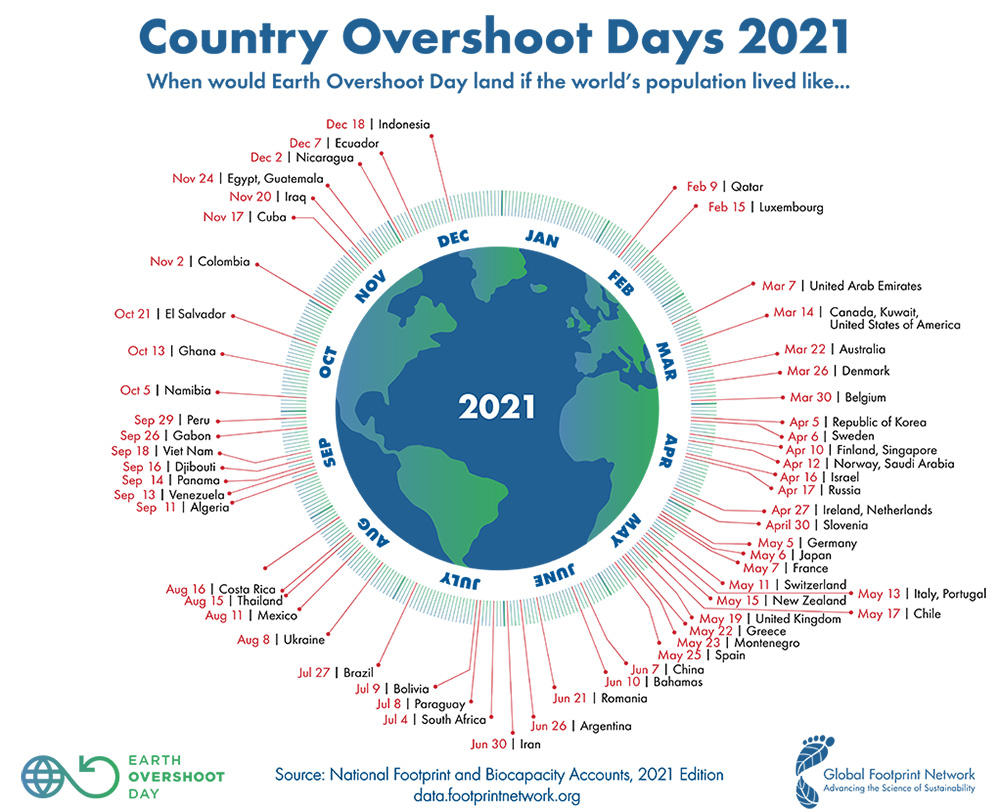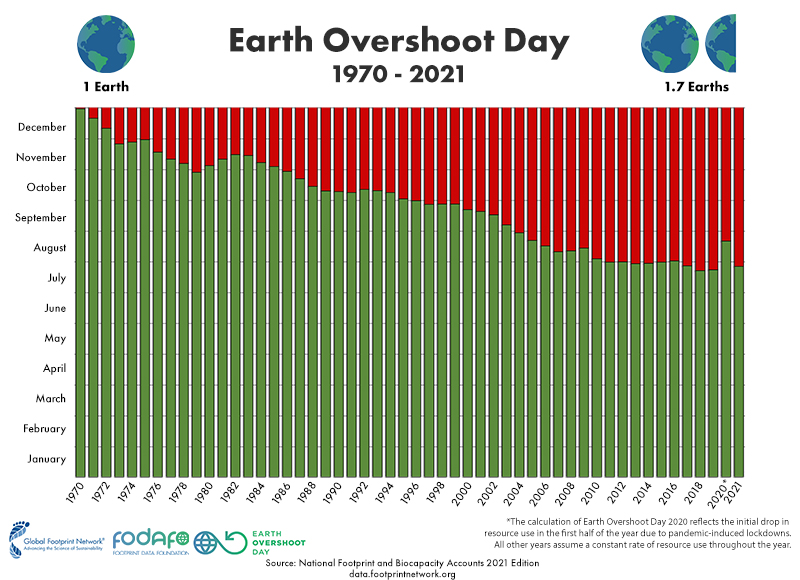
By Anders Lorenzen
29th of July was the day calculated as Earth Overshoot Day for 2021, the day which marks the date when humanity’s demand for ecological resources and services in a given year exceeds what Earth can regenerate in that year. Humanity currently uses 74% more resources than the planet’s ecosystems can regenerate—or the equivalent of “1.7 Earths.” From now until the end of the year, humanity is essentially operating on ecological deficit spending. This spending is currently some of the largest since the world entered into ecological overshoot in the early 1970s, according to the National Footprint & Biocapacity Accounts (NFA) based on UN datasets. Since the 1970’s, Earth Overshoot Day has gradually been happening earlier and earlier each year, with the exception of last year due to uncharacteristic behaviours during pandemic. The 2021 date is almost as early as the 2019 one (the 2020 date was pushed back due to COVID-19 induced lockdowns), showcasing the increasing impact of humanity on Earth’s biocapacity.

The drivers
The notable drivers of consumption is the 6.6% carbon footprint increase over last year, as well as the 0.5% decrease in global forest biocapacity due in large part to the spike in Amazon deforestation. In Brazil alone, 1.1 million hectares of forest were lost in 2020 and estimates for 2021 indicate up to 43% year-over-year increase in deforestation.
In 2021 the carbon footprint of transportation will remain lower than pre-pandemic levels. CO2 emissions from domestic air travel and road transport are set to remain 5% below 2019 levels, while international aviation is expected to register 33% below 2019 levels, according to the International Energy Agency (IEA), however as lockdowns are eased this can be expected to rebound. Global energy-related CO2 emissions, on the other hand, are projected to rebound and grow by 4.8% from last year as the economic recovery from the pandemic ignites demand for fossil fuels. In particular, global coal use is anticipated to jump in 2021 and is estimated to contribute 40% of the total carbon footprint this year.
Global Footprint Network (who organises Earth Overshoot Day) CEO Laurel Hanscom said: “this data makes abundantly clear that recovery plans in the post-COVID 19 era can only be successful in the long-term if they embrace regeneration and ecological resource-efficiency.”
All eyes on Glasgow
In November all eyes will be on Glasgow, UK as it prepares to host the crucial UN climate summit COP26. Leader of Glasgow City Council, Councillor Susan Aitken, said: “Let Earth Overshoot Day be our call to arms. The climate summit needs to make the decisions that will deliver our planet on a safer and more sustainable future. We’ve got the opportunity here in Glasgow to show the world what we’re doing, coalescing together as a city to show real change, to respond to the climate and ecological emergency. Let’s put our planet first.”
Global Footprint Network believes that the pandemic showed that governments demonstrated they can act swiftly, both in terms of regulations and spending, when they put human lives above all else. The perfect storm that is brewing, as climate change impacts and biological resource security converge, requires the same level—or higher—of alertness and swift action from decision-makers.
Who is responsible
Of course, there’s a big difference in which countries bear the responsibility for carbon emissions and the collapse of biocapacity. The US remains the historically highest emitter in the world and as a country, due to the consumption habits of the average American, and they also have the highest ecological footprint per capita in the world. In addition, due to the accelerating deforestation in the Amazon rainforest, which has sped up under president Jair Bolsonaro, one can’t ignore the huge responsibility and the impact of Brazil’s forestry and environment policies.
To determine the date of Earth Overshoot Day each year, Global Footprint Network calculates the number of days of that year that Earth’s biocapacity suffices to provide for humanity’s Ecological Footprint. The remainder of the year corresponds to global overshoot. Earth Overshoot Day is computed by dividing the planet’s biocapacity (the amount of ecological resources Earth can generate that year), by humanity’s Ecological Footprint (humanity’s demand for that year), and multiplying by 365, the number of days in a year.
Categories: Earth, environment, resources, sustainability
6 replies »